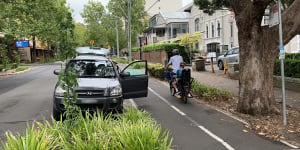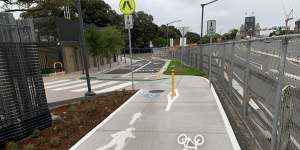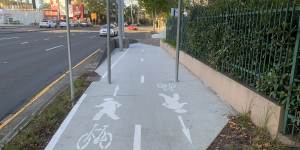I’d been “doored” by a van driver who timed his opening perfectly to snap my collarbone cleanly in two. People at the bus stop stepped onto the road and prevented me from being run over.

A bike path built on Ridge Street in North Sydney is typical of the dangerous design of bike lanes that puts cyclists at risk from car doors swinging into their path.Nigel Gladstone
In the 15 years since,I’ve continued to commute by bike despite enduring abuse,being called “selfish” for choosing to pedal or that I should not be on the road because “I don’t pay rego”.
It’s an undeniable truth that Sydney hates bikes. Share bikes are thrown into rivers,ponds and formed into scrap-heap sculptures. People regularly abuse cyclists on talkback radio. Pedestrians and politicians describe riders as a “menace”. But it’s the drivers who are the menace. It’s time we started to hate cars for very rational reasons.
Motorists kill dogs,cats and other animals daily. They emit unpleasant odours and noises when performing basic functions like accelerating,braking,booming bad music or beeping each other due to the frustrations they feel when too many of them are around,go too slow,or change lanes.
They drive up the cost of living and housing with compulsory parking spaces adding thousands to the price of apartments and millions more for almost every other type of building. Furthermore,they occupy millions of metres of public space.

A new bike path alongside the Harbour Bridge is made more dangerous by a bollard.Nigel Gladstone
Hospitals are burdened by the thousands of people injured or killed by drivers each year. And yet to drivers who use toll roads as governments at all levels have their budgets burdened by billions for new and old bitumen.
We need roads for freight and tradies and not everyone can cope or commute without a car. But it’s time we start to seriously consider better,cheaper,healthier ways to ease the city’s transport burden.
Cycling is the except Sydney,which has allocated barely any money for bike paths – just $97.9 million in the NSW budget for “active transport” which includes pedestrian paths – over the four years to 2026/7.
Cycling in Sydney is institutionally despised,too. A connected bike network across the city is not planned,funded or discussed outside a “strategy” document which contemplates a network that might be built in.

A bike path in Artarmon next to the Pacific Highway is not only too small for two bikes to ride,it’s also got sign posts stuck in the middle.Nigel Gladstone
Bikes are not allowed on buses,for the safety of passengers,I’m told. The exclusion of cyclists extends to new roads and upgraded ones such as the that does not include any space for bikes,despite 16 lanes being built for traffic.
When a new bike path dares to claim a small space on a road where cars are parked freely, tend to band together and protest against the plans. Heaven forbid a bike path takes a few hundred metres of public space from the hundreds of thousands of kilometres that parked cars occupy. It would be best if,when bike lanesare built,they don’t share space with pedestrians,or utilities or sign posts or have cars parked so close to them that their doors open into the bike path.
E-bikes are restricted from going faster than 25km/h in NSW. This makes riding in traffic dangerous as the bike motor helps you accelerate and then cuts out as traffic catches up. Then the motor kicks in and out continuously at low speeds. In and the limit is 32 to 45km/h,which improves commuting for all.
Last week,new plans were hatched to because they may pose a fire risk. This is a real safety issue but. Sometimes cars burst into flames.
So if we move past the rage against machines that make no noise,and harm very few,how can we take them mainstream and sideline expensive,dangerous,polluting,taxpayer-money-sucking vehicles?
Adding bike racks to buses would help commuters who travel long distances and remove a few road-raged drivers stuck at spaghetti junctions. It wouldn’t cost much and provides a failsafe for riders whose tires are punctured by broken glass and twisted metal from car crashes.
An e-bike subsidy,similar to the electric car incentives,could encourage a switch that saves more carbon dioxide and infrastructure than an electric car. These ideas have been successfully implemented overseas. The and are even entitled to a bicycle allowance for commuting.
If a few more safe bike lanes are built,fewer people will drive to work or the shops or schools,and we’ll get a less polluted,less expensive,safer environment. But we need to stop hating cyclists and start criticising the car-centred policies that have cost us so much already.
Nigel Gladstone is an investigative journalist atThe Sydney Morning Herald.